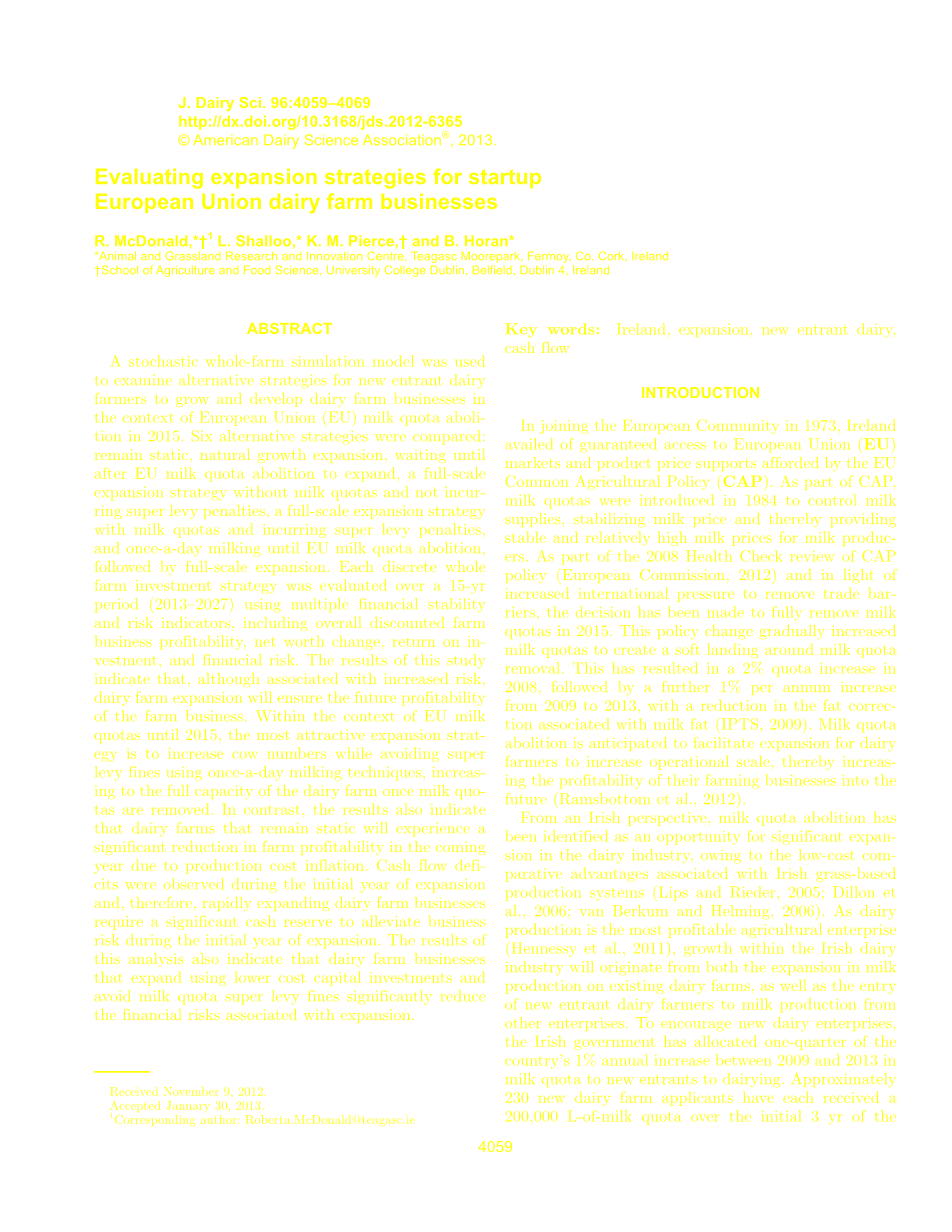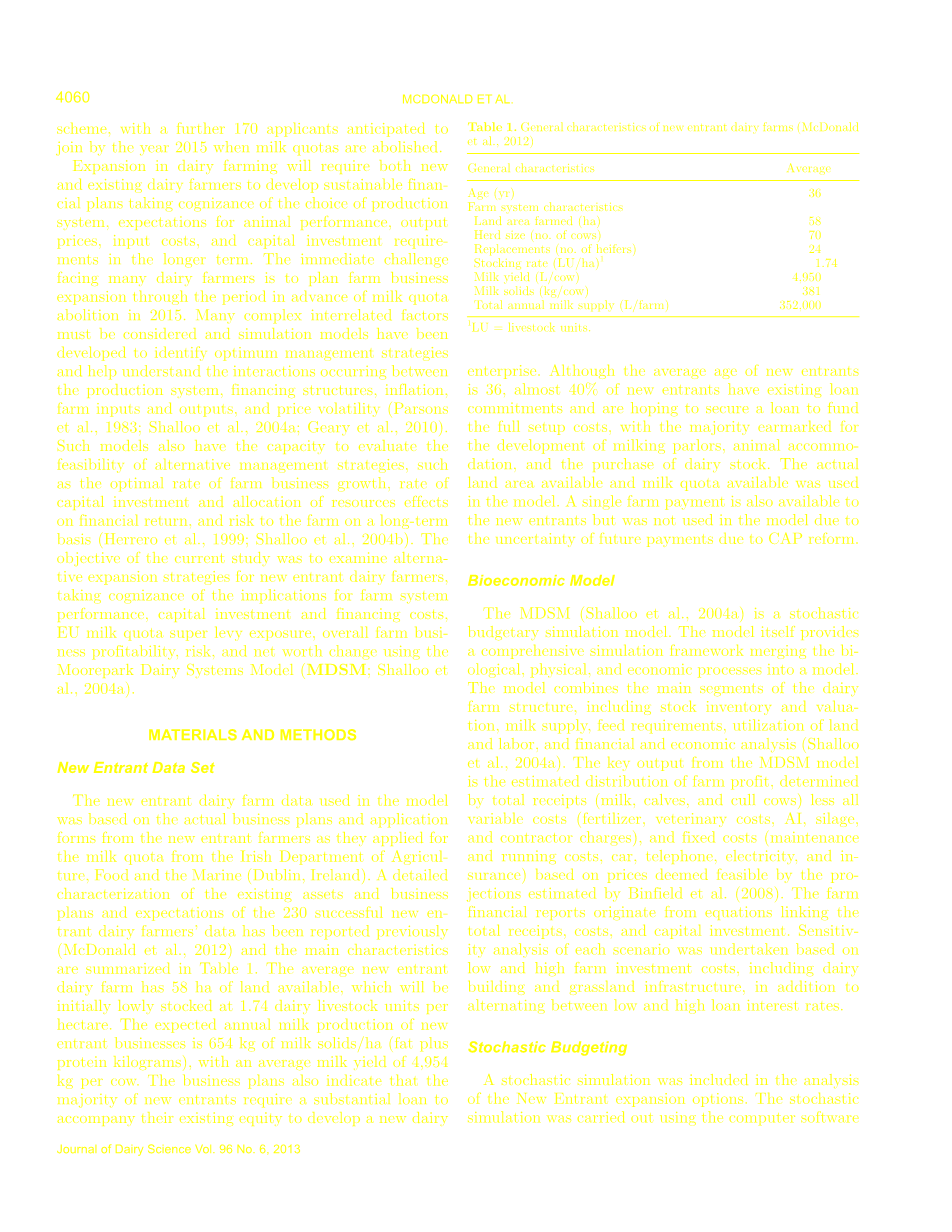

英语原文共 11 页,剩余内容已隐藏,支付完成后下载完整资料
A stochastic whole-farm simulation model was used to examine alternative strategies for new entrant dairy farmers to grow and develop dairy farm businesses in the context of European Union (EU) milk quota abolition in 2015. Six alternative strategies were compared: remain static, natural growth expansion, waiting until after EU milk quota abolition to expand, a full-scale expansion strategy without milk quotas and not incurring super levy penalties, a full-scale expansion strategy with milk quotas and incurring super levy penalties, and once-a-day milking until EU milk quota abolition, followed by full-scale expansion. Each discrete whole farm investment strategy was evaluated over a 15-yr period (2013–2027) using multiple financial stability and risk indicators, including overall discounted farm business profitability, net worth change, return on investment, and financial risk. The results of this study indicate that, although associated with increased risk, dairy farm expansion will ensure the future profitability of the farm business. Within the context of EU milk quotas until 2015, the most attractive expansion strategy is to increase cow numbers while avoiding super levy fines using once-a-day milking techniques, increasing to the full capacity of the dairy farm once milk quotas are removed. In contrast, the results also indicate that dairy farms that remain static will experience a significant reduction in farm profitability in the coming year due to production cost inflation. Cash flow deficits were observed during the initial year of expansion and, therefore, rapidly expanding dairy farm businesses require a significant cash reserve to alleviate business risk during the initial year of expansion. The results of this analysis also indicate that dairy farm businesses that expand using lower cost capital investments and avoid milk quota super levy fines significantly reduce the financial risks associated with expansion.
In joining the European Community in 1973, Ireland availed of guaranteed access to European Union (EU) markets and product price supports afforded by the EU Common Agricultural Policy (CAP). As part of CAP, milk quotas were introduced in 1984 to control milk supplies, stabilizing milk price and thereby providing stable and relatively high milk prices for milk producers. As part of the 2008 Health Check review of CAP policy (European Commission, 2012) and in light of increased international pressure to remove trade barriers, the decision has been made to fully remove milk quotas in 2015. This policy change gradually increased milk quotas to create a soft landing around milk quota removal. This has resulted in a 2% quota increase in 2008, followed by a further 1% per annum increase from 2009 to 2013, with a reduction in the fat correction associated with milk fat (IPTS, 2009). Milk quota abolition is anticipated to facilitate expansion for dairy farmers to increase operational scale, thereby increasing the profitability of their farming businesses into the future (Ramsbottom et al., 2012).
From an Irish perspective, milk quota abolition has been identified as an opportunity for significant expansion in the dairy industry, owing to the low-cost comparative advantages associated with Irish grass-based production systems (Lips and Rieder, 2005; Dillon et al., 2006; van Berkum and Helming, 2006). As dairy production is the most profitable agricultural enterprise (Hennessy et al., 2011), growth within the Irish dairy industry will originate from both the expansion in milk production on existing dairy farms, as well as the entry of new entrant dairy farmers to milk production from other enterprises. To encourage new dairy enterprises, the Irish government has allocated one-quarter of the countryrsquo;s 1% annual increase between 2009 and 2013 in milk quota to new entrants to dairying. Approximately 230 new dairy farm applicants have each received a 200,000 L-of-milk quota over the initial 3 yr of the scheme, with a further 170 applicants anticipated to join by the year 2015 when milk quotas are abolished. Expansion in dairy farming will require both new and existing dairy farmers to develop sustainable financial plans taking cognizance of the choice of production system, expectations for animal performance, output prices, input costs, and capital investment requirements in the longer term. The immediate challenge facing many dairy farmers is to plan farm business expansion through the period in advance of milk quota abolition in 2015. Many complex interrelated factors must be considered and simulation models have been developed to identify optimum management strategies and help understand the interactions occurring between the production system, financing structures, inflation, farm inputs and outputs, and price volatility (Parsons et al., 1983; Shalloo et al., 2004a; Geary et al., 2010). Such models also have the capacity to evaluate the feasibility of alternative management strategies, such as the optimal rate of farm business growth, rate of capital investment and allocation of resources effects on financial return, and risk to the farm on a long-term basis (Herrero et al., 1999; Shalloo et al., 2004b). The objective of the current study was to examine alternative expansion strategies for new entrant dairy farmers, taking cognizance of the implications for farm system performance, capital investment and financing costs, EU milk quota super levy exposure, overall farm business profitability, risk, and net worth change using the Moorepark Dairy Systems Model (MDSM; Shalloo et al., 2004a).
The new entrant dairy farm data used in the model was based on the actual business plans and application forms from the new entrant farmers as they applied for the milk quota from the Irish Department of Agriculture, Food and the Marine (Dublin, Ireland). A detailed characterization of the existing assets and business plans and expectations of the 230 successful new entran
全文共26420字,剩余内容已隐藏,支付完成后下载完整资料
资料编号:[3088]


